Nokia Lumia 830 Review
by Brett Howse on November 25, 2014 8:00 AM EST- Posted in
- Smartphones
- Microsoft
- Lumia
Display
Features such as two-stage camera buttons, multiple microphones for noise cancellation and surround sound video recording, and LTE connectivity are all great, but the one thing you use on any smartphone the most is the display. This means that a good display is something that all manufacturers should focus on. The improvements to smartphone displays over the last several years have been pretty dramatic, but it is still one area where a phones with similar internals can differentiate themselves from the competition.
The Lumia 830 has a five inch 1280x720 resolution IPS LCD. The Lumia line has alternated between Organic LED displays and Liquid Crystal Displays for many of their models. This particular device did end up with a LCD though, which brings the strengths and weaknesses of LCD along with it. Generally, color reproduction is better on a LCD but black levels and contrast cannot match OLED displays, with only the most recent Samsung OLED panels bucking that trend. The resolution of the Lumia 830 is a bit off the 1080p displays we see on higher end phones, but at 294 pixels per inch it is reasonably sharp and falls just under the iPhone 6 and its 326 pixels per inch.
As you can see in the above image, another advantage of LCD is that they are generally a RGB stripe, so there are no extra pixels or pentile matrices to deal with.
As with the Lumia 930, the Lumia 830 also supports “sunlight readability enhancements” which is a method of doing per pixel based content-adaptive backlight control from Apical which helps the perceived image when the device is used outdoors. The brightness is much higher on the 830 than the 930, but these additions can make the device much more usable outdoors.
One of the issues I had with the Lumia 630 when I reviewed it was the display had an almost matte texture to it which caused your finger to catch and drag when using the touchscreen. The Lumia 830’s ClearBlack display suffers none of this, and has a wonderful smooth coating on it which is also easy to clean. One other feature that seems to be somewhat exclusive to Lumia phones is Super Sensitive touch which allows the device to be used with gloves on and still interact with the touch screen. As you will see in the upcoming camera section, this is appreciated in colder climates.
To test the display accuracy, we turn to Spectralcal’s CalMAN 5 software package with a custom workflow. We utilize the X-Rite i1Pro Spectrophotometer for color accuracy and saturation, and the X-Rite i1Display Pro for contrast ratios.

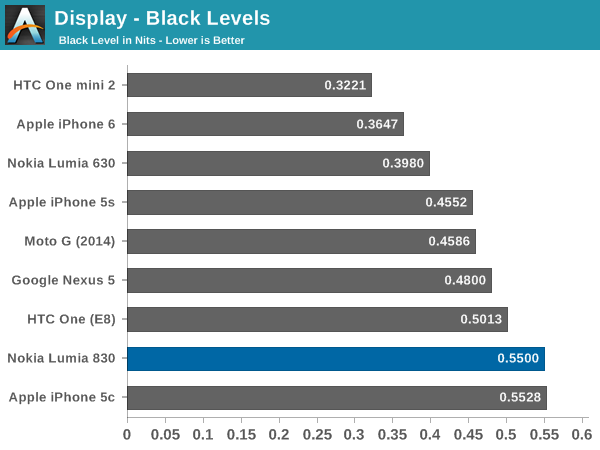
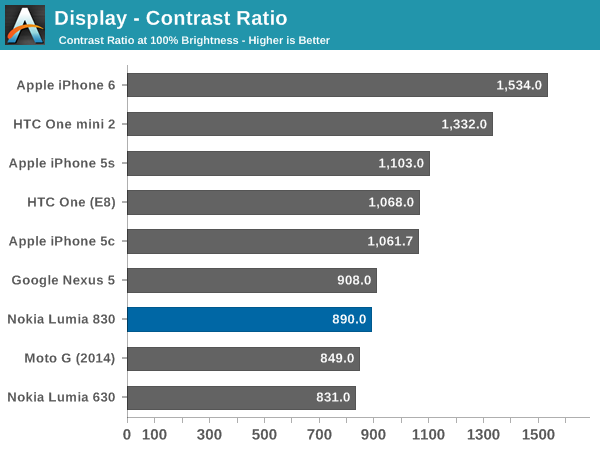
At almost 500 nits, the Lumia 830 is plenty bright for most situations. However the relatively poor black levels result in a contrast ratio that is not spectacular. The black levels are the one thing I noticed while using this device especially when my daily phone is OLED.
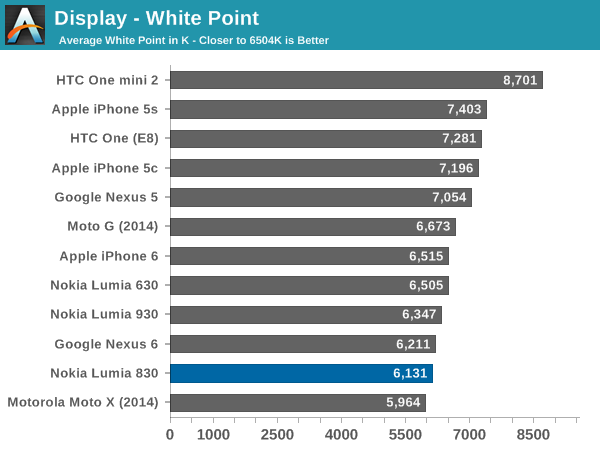

The white point on the Lumia 830 is a bit under what we would be looking for, however you can see from the Calman results that the green starts to shift quite high as the white level rises. That combined with the blue falling away results in a less than amazing 5.207 grayscale average dE2000 score. It is not a great result especially when compared to the Lumia 630, which was one of the better scoring phone displays we have tested and is in a much cheaper device from the same manufacturer. It is clear that the Lumia line has not yet taken display calibration seriously.
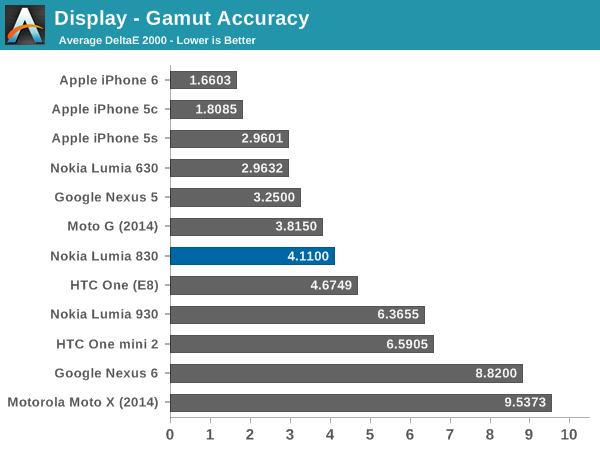
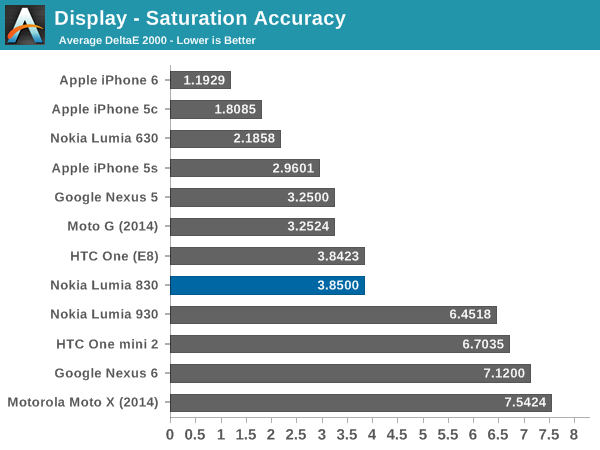
The saturation sweeps are a bit better than grayscale. We are looking for values under 3, and the Lumia 830 is not too far off this mark. At 3.85, it is still quite a way from the Lumia 630’s 2.18 though.
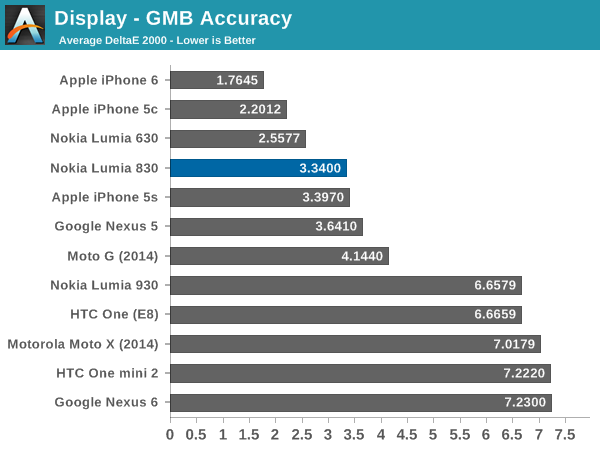
The Lumia 830 does fairly well in the GMB checker, despite the poor grayscale. It comes in with a good, but not great result, and still falls short of the Lumia 630.
The Lumia 830 does support the recently added options for an advanced color profile, which will allow a user to adjust the display to one of three presets (Standard, Vivid, Cool) or to choose Advanced and manually adjust color temperature, tint, and saturation. We are still without a mobile operating system with full color profile support, but this is a good step in the right direction.
Using these settings, you should be able to pull the green down a bit in order to correct the display. The disappointment is that the display is not correct when it leaves the factory though.
The Lumia 830 ends up with a middle of the road LCD. Black levels are not the greatest, but the overall accuracy of the display is not so far off the charts as to be unusable either. The white point is a bit low, but better than some displays which come from the factor with a huge blue shift.


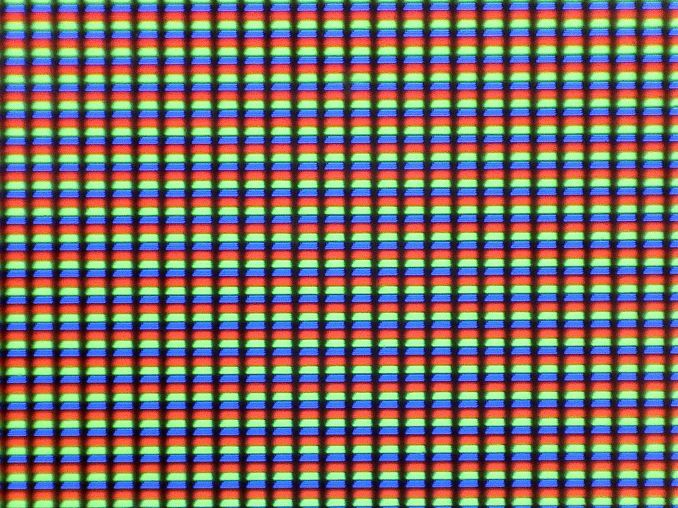



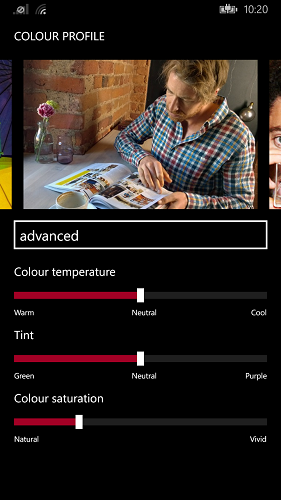








98 Comments
View All Comments
kspirit - Wednesday, November 26, 2014 - link
In addition: I am aware that the design of the 830 probably hadn't started at the time of the acquisition. But I can't believe the same Nokia who put glance and camera buttons on even the 620 two years ago wouldn't do it in the x30 refreshes. Especially considering that those were unique, signature capabilities that competing manufacturers don't offer. MS must have had some input in this phone. I'm sure they would have cared about cost cutting on the company they were just on the brink of acquiring. No?cheshirster - Friday, November 28, 2014 - link
Glance and camera button obviously presented on L830 :)You should be really high on something to blame it for having features that 730 and 630 are missing.
retrospooty - Monday, December 1, 2014 - link
Yeah, I dont think he is grasping the Tiered model#'s and the concept of price points. He seems to be assuming newer is always higher end, even on a lower end model.Now if the 925 replacement came out and was lesser than the 925 he would have a great point. But the 830 is NOT the 925 replacement model.
Sabresiberian - Tuesday, November 25, 2014 - link
Keep in mind that Microsoft/Nokia hasn't released anything intended to be more than a midrange or low-end phone since the Icon/930. It may look like they are cutting back to those of us interested in flagship devices - but it isn't really the case. :)close - Tuesday, November 25, 2014 - link
Well... they are using the same low-end SoC on 4 of their product lines which is disappointing (5xx, 6xx, 7xx, 8xx). And for a smart phone some CPU performance is a must otherwise the experience is really frustrating. More so than not having some niche features like glance. I'm not talking about intensive 3D games, but it should allow the user to comfortably run applications without feeling the performance hit. I was expecting the 830, maybe even the 730, to have the 600 series SoC. MS/Nokia have skipped the mid-range and went from low-end to high-end. Although the premium build and other features don't really compensate for the distinct lack of snappiness in applications.It's like building a premium sedan with a 1l engine.
melgross - Tuesday, November 25, 2014 - link
I imagine they're trying to save money. Considering g how small sales are, they need to buy fewer parts in larger quantity to have any hope of a profit, which, from looking at Microsoft's financials shows isn't likely happening.They are also concentrating on lower priced models in order to attempt to get sales in China, where they've fallen to 0.6%, and India, where sales are down as well. Samsung seems to be working on the same strategy, from their last announcement.
PubFiction - Tuesday, November 25, 2014 - link
They need to stop thinking about making money and start thinking about releasing an attractive product and actually getting people to buy their stuff. Nickel and diming right now is not going to work.cheshirster - Friday, November 28, 2014 - link
Their sales are two-three times larger then HTC and larger then Moto for many quarters (if you think moto g's and e's are selling in BIG quantities you a wrong)Alexvrb - Tuesday, November 25, 2014 - link
Doesn't sound like you've really used one. :/ Don't get me wrong, I do game and I wouldn't buy one as a result. But you specifically said "I'm not talking about intensive 3D games". So, taking those out of the equation... even with the "slow" CPU, it does everything you're talking about just fine. They really run great, and the OS has superb SD card support - which negates the only major drawback I could hurl at this phone, the lack of storage.But again, since I do game occasionally on my phone, I would want a flagship. The Icon and M8 are both very nice models. However even those are going to need replacement in the not-so-distant future, and I hope Verizon stops being a Big Red Baby and works hand in hand with MS on future phone releases and updates alike.
close - Wednesday, November 26, 2014 - link
Actually I did get the chance to test drive one of these (I do some hardware compliance so I get to test drive most relevant devices on the market, at least to get a rough idea about them). The OS itself is more than snappy on this CPU. But try to use it as any normal person would use a smartphone and it starts to choke. Loading applications or switching between application takes a long time. It's just not the experience I was expecting. Don't get me wrong, the device doesn't become unusable. It's just that at this price point at given the 8xx series position in MS's product lineup I have some higher expectations when using the phone.MS was careful to create an OS that runs great on low-end hardware but this isn't the case for software makers. And your smartphone is defined by the applications it runs and how it runs them.
Bottom line, it's a nice phone but given the competition it's too expensive for its worth.